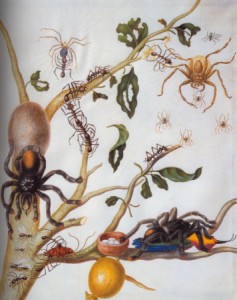READY TO GET STARTED?
REQUEST A FREE ESTIMATE
Fill out the form below or call (888) 466-7849 for a free, no-obligation estimate.
Everyone knows that warmer weather, mixed with a little rain and lots of sunshine makes for a spring full of bloom and growth. However, it may not be as common knowledge that, just like plants, insect population growth responds to certain types of weather, while being discouraged by some other weather patterns. In particular, temperature and moisture have quite an effect, especially during the warm and dry weather months of April, May, and June.
Temperature has such a significant effect because insects are poikilothermic, which means cold-blooded. Cold-blooded animals are unable to regulate their body temperature, so the environmental temperature affects their internal temperature. Certain insects develop rapidly when environment temperatures are in the 85-90 degree range. Development alone is not the only aspect of insect life affected by temperature, but also insect behavior such as flight, movement, reproduction and feeding. Extreme temperatures, whether very hot (> 120 degrees Fahrenheit) or extremely cold (< 32 degrees Fahrenheit) makes insect growth and behavior restricted and is often deadly.
Moisture is important in a way that most people don’t expect. Humidity itself affects insect development, because low humidity can make it difficult for an insect to regulate it’s water loss. Alternatively, too much moisture, such as excessive rainfall or winter storms, can damage insects. The amount of moisture in an insect’s environment is particularly important for those who depend on crops as their food supply. Cold, wet moisture extremes can also lead to disease, slow growth rates and disturb feeding patterns.
Melissa Brown
[email protected]
Everyone knows that warmer weather, mixed with a little rain and lots of sunshine makes for a spring full of bloom and growth. However, it may not be as common knowledge that, just like plants, insect population growth responds to certain types of weather, while being discouraged by some other weather patterns. In particular, temperature and moisture have quite an effect, especially during the warm and dry weather months of April, May, and June.
Temperature has such a significant effect because insects are poikilothermic, which means cold-blooded. Cold-blooded animals are unable to regulate their body temperature, so the environmental temperature affects their internal temperature. Certain insects develop rapidly when environment temperatures are in the 85-90 degree range. Development alone is not the only aspect of insect life affected by temperature, but also insect behavior such as flight, movement, reproduction and feeding. Extreme temperatures, whether very hot (> 120 degrees Fahrenheit) or extremely cold (< 32 degrees Fahrenheit) makes insect growth and behavior restricted and is often deadly.
Moisture is important in a way that most people don’t expect. Humidity itself affects insect development, because low humidity can make it difficult for an insect to regulate it’s water loss. Alternatively, too much moisture, such as excessive rainfall or winter storms, can damage insects. The amount of moisture in an insect’s environment is particularly important for those who depend on crops as their food supply. Cold, wet moisture extremes can also lead to disease, slow growth rates and disturb feeding patterns.
Source
Melissa Brown
[email protected]
When you reflect on famous artists and their work, like the Mona Lisa by DaVinci for instance, you can immediately appreciate the beauty of their masterpiece. However, when the subject of an artwork is an insect, you might have a little more trouble seeing the beauty in it before wanting to call an exterminator! The brave souls who did make insects their muse had an appreciation for natural history, especially during the 17th century.
Studying bugs for their connection to the earth and nature led to some beautiful creations by Albrecht Dürer such as the Stag Beetle. Dürer said of art, “It is indeed true that art is omnipresent in nature, and the true artist is he who can bring it out.”
Some artists liked to focus on butterflies because they represented transformation and resurrection. Wenceslaus Hollar’s drawing Forty-One Insects, Moths and Butterflies features a collection of bugs of different varieties on displaying much like a “cabinet of curiosity.” Check out this painting and more below!

Maria Sibyla Merian, Branch of guava tree with leafcutter ants, army ants, pink-toed tarantulas, c. 1701-5
Melissa Brown
[email protected]
Source:
http://venetianred.net/2010/04/20/the-busy-bee-has-no-time-for-sorrow-insects-in-art/
 Spotting a spider or roach may cause someone to jump from fright. Most people who have a typical fear of bugs may have these fears for various reasons. For instance, people who avoid bees may have a legitimate concern about being stung, especially if they’ve been stung before and found themselves to be allergic. Some bugs such as bees, wasps, poisonous spiders and mosquitoes can carry threats that many people try to protect themselves from. Northwest Exterminating provides an extensive amount of services to protect homes and businesses from such threats.
Spotting a spider or roach may cause someone to jump from fright. Most people who have a typical fear of bugs may have these fears for various reasons. For instance, people who avoid bees may have a legitimate concern about being stung, especially if they’ve been stung before and found themselves to be allergic. Some bugs such as bees, wasps, poisonous spiders and mosquitoes can carry threats that many people try to protect themselves from. Northwest Exterminating provides an extensive amount of services to protect homes and businesses from such threats.
Then there are the bugs that may not carry much of a threat but we know the sight of them indicates other unpleasant conditions. Flies and roaches tend to flock to places that are unhygienic and not the cleanest. Maintaining a clean living and working environment usually helps eliminate the presence of these bugs, as well as the related fear. Our preference for a bug-free environment may be due to that in more industrialized, urbanized societies, we do not have firsthand experience with bugs because we do not live in their natural environment. Out of sight is out of mind, so spotting an unusual insect might always be a little bit surprising.
Other people have much more than an aversion, but rather a legitimate fear of insects otherwise known as entomophobia. A well-known form of entomophobia is arachnophobia, the fear of spiders. As the definition suggestions, the fear or concern has little to do with bugs themselves and more to do with somebody’s psychological disposition. Northwest Exterminating may not be able to fix your fears, but we can certainly take care of the bugs for you. Call us today to schedule an appointment!
Melissa Brown
[email protected]
Happy 4th of July!! We’d like to take a second to say how proud we are to be Americans!! We’re proud to live in the country of the land of the free and the home of the brave!! And like always, we’d like to thank all of the brave men and women and their families that have given so much for this great country!!
But before you go enjoy those fireworks…here are some tips to stay bug free this 4th of July:
What other tips do have for staying bug free this 4th of July?